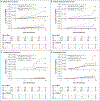Prospective Study of Outcomes in Adults with Nonalcoholic Fatty Liver Disease
- PMID: 34670043
- PMCID: PMC8881985
- DOI: 10.1056/NEJMoa2029349
Prospective Study of Outcomes in Adults with Nonalcoholic Fatty Liver Disease
Abstract
Background: The prognoses with respect to mortality and hepatic and nonhepatic outcomes across the histologic spectrum of nonalcoholic fatty liver disease (NAFLD) are not well defined.
Methods: We prospectively followed a multicenter patient population that included the full histologic spectrum of NAFLD. The incidences of death and other outcomes were compared across baseline histologic characteristics.
Results: A total of 1773 adults with NAFLD were followed for a median of 4 years. All-cause mortality increased with increasing fibrosis stages (0.32 deaths per 100 person-years for stage F0 to F2 [no, mild, or moderate fibrosis], 0.89 deaths per 100 persons-years for stage F3 [bridging fibrosis], and 1.76 deaths per 100 person-years for stage F4 [cirrhosis]). The incidence of liver-related complications per 100 person-years increased with fibrosis stage (F0 to F2 vs. F3 vs. F4) as follows: variceal hemorrhage (0.00 vs. 0.06 vs. 0.70), ascites (0.04 vs. 0.52 vs. 1.20), encephalopathy (0.02 vs. 0.75 vs. 2.39), and hepatocellular cancer (0.04 vs. 0.34 vs. 0.14). As compared with patients with stage F0 to F2 fibrosis, patients with stage F4 fibrosis also had a higher incidence of type 2 diabetes (7.53 vs. 4.45 events per 100 person-years) and a decrease of more than 40% in the estimated glomerular filtration rate (2.98 vs. 0.97 events per 100 person-years). The incidence of cardiac events and nonhepatic cancers were similar across fibrosis stages. After adjustment for age, sex, race, diabetes status, and baseline histologic severity, the incidence of any hepatic decompensation event (variceal hemorrhage, ascites, or encephalopathy) was associated with increased all-cause mortality (adjusted hazard ratio, 6.8; 95% confidence interval, 2.2 to 21.3).
Conclusions: In this prospective study involving patients with NAFLD, fibrosis stages F3 and F4 were associated with increased risks of liver-related complications and death. (Funded by the National Institute of Diabetes and Digestive and Kidney Diseases and others; NAFLD DB2 ClinicalTrials.gov number, NCT01030484.).
Copyright © 2021 Massachusetts Medical Society.
Figures


Comment in
-
Natural history of NAFLD: knowns and unknowns.Nat Rev Gastroenterol Hepatol. 2022 Mar;19(3):151-152. doi: 10.1038/s41575-021-00565-8. Nat Rev Gastroenterol Hepatol. 2022. PMID: 34880412 No abstract available.
-
Nonalcoholic Fatty Liver Disease.N Engl J Med. 2022 Jan 20;386(3):294. doi: 10.1056/NEJMc2118255. N Engl J Med. 2022. PMID: 35045235 No abstract available.
-
Nonalcoholic Fatty Liver Disease.N Engl J Med. 2022 Jan 20;386(3):294-295. doi: 10.1056/NEJMc2118255. N Engl J Med. 2022. PMID: 35045236 No abstract available.
-
Nonalcoholic Fatty Liver Disease.N Engl J Med. 2022 Jan 20;386(3):295. doi: 10.1056/NEJMc2118255. N Engl J Med. 2022. PMID: 35045237 No abstract available.
-
Assessing liver fibrosis in all patients with type 2 diabetes and fatty liver disease: It's time to act now.J Diabetes Investig. 2022 May;13(5):762-764. doi: 10.1111/jdi.13765. Epub 2022 Feb 16. J Diabetes Investig. 2022. PMID: 35119217 Free PMC article. No abstract available.
-
Long-term outcomes in patients with non-alcoholic fatty liver disease: further evidence that a multidisciplinary and patient-centred approach to treatment is needed.Hepatobiliary Surg Nutr. 2022 Feb;11(1):143-146. doi: 10.21037/hbsn-21-528. Hepatobiliary Surg Nutr. 2022. PMID: 35284520 Free PMC article. No abstract available.
References
-
- Younossi ZM, Koenig AB, Abdelatif D, Fazel Y, Henry L, Wymer M. Global epidemiology of nonalcoholic fatty liver disease — meta-analytic assessment of prevalence, incidence, and outcomes. Hepatology 2016;64:73–84. - PubMed
Publication types
MeSH terms
Associated data
Grants and funding
- K23 DK119460/DK/NIDDK NIH HHS/United States
- UL1 TR002649/TR/NCATS NIH HHS/United States
- U01 DK061731/DK/NIDDK NIH HHS/United States
- UL1 TR000006/TR/NCATS NIH HHS/United States
- U01 DK061728/DK/NIDDK NIH HHS/United States
- UL1 TR000439/TR/NCATS NIH HHS/United States
- U01 DK061738/DK/NIDDK NIH HHS/United States
- UL1 TR000448/TR/NCATS NIH HHS/United States
- U01 DK061734/DK/NIDDK NIH HHS/United States
- UL1 TR000004/TR/NCATS NIH HHS/United States
- UL1 TR002345/TR/NCATS NIH HHS/United States
- UL1TR000439, UL1TR000436, UL1TR000006, UL1TR000448/TR/NCATS NIH HHS/United States
- U01 DK061737/DK/NIDDK NIH HHS/United States
- U01 DK061713/DK/NIDDK NIH HHS/United States
- U01 DK061732/DK/NIDDK NIH HHS/United States
- UL1 TR002548/TR/NCATS NIH HHS/United States
- U01 DK061718/DK/NIDDK NIH HHS/United States
- UL1 TR001442/TR/NCATS NIH HHS/United States
- U01DK061713, U01DK061718, U01DK061728, U01DK061731/National Institute of Diabetes and Digestive and Kidney Diseases (NIDDK)
- UL1 TR000436/TR/NCATS NIH HHS/United States
- U01 DK061730/DK/NIDDK NIH HHS/United States
- U24 DK061730/DK/NIDDK NIH HHS/United States
- UL1 TR000423/TR/NCATS NIH HHS/United States
- UL1 TR000100/TR/NCATS NIH HHS/United States
LinkOut - more resources
Full Text Sources
Other Literature Sources
Medical
Research Materials
Miscellaneous
